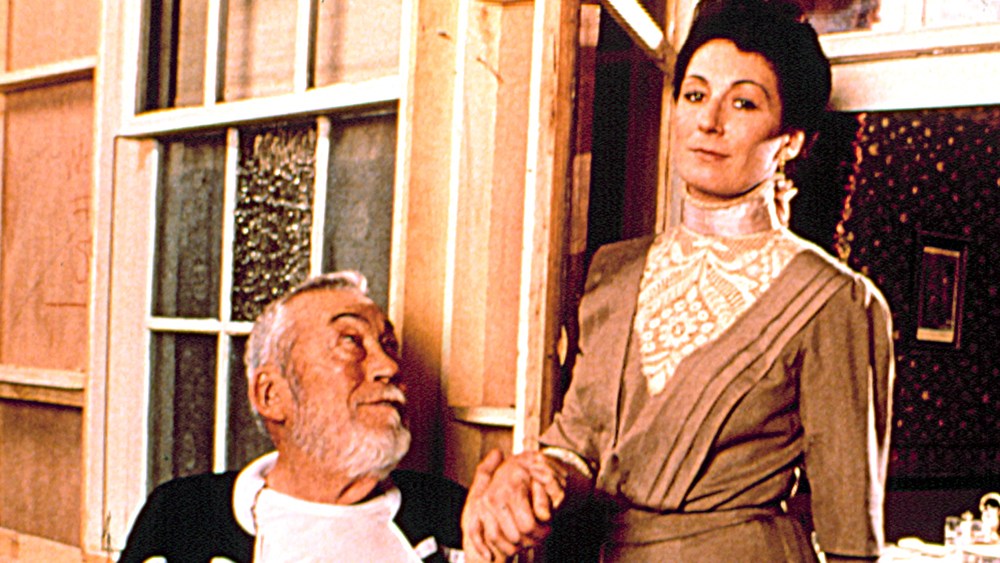Late style can seem like a safe haven for the modern movie lover. Whether its the sparse styling of Clint Eastwood’s “Juror #2” or the multi-million-dollar gonzo flair of Francis Ford Coppola’s “Megalopolis,” there’s a vital, existential intrigue to directors who may seem over the hill, or encased in amber, and who can be easily dismissed as unfashionable.
“Nobody will admit that about Clint Eastwood though! Everybody on the internet is a Clint auteurist,” Karina Longworth says, chuckling. The film historian and former critic has been the writer and host of her podcast “You Must Remember This” since 2014. “It was definitely that in terms of ‘Megalopolis.’ … It is very easy to write off Coppola as a rich old man who doesn’t have to answer to anyone but himself and to say that that’s a problem. But the out-of-timeness, looking backwards and forwards, is what’s exciting about it.”
For the latest season of her podcast, Longworth transports listeners to the New Hollywood— a time when filmmakers like Coppola and Eastwood were about to take power, just as Golden Age mainstays like John Ford and Alfred Hitchcock (among the subjects this season) felt the ground shift beneath them, or even crack open to swallow them whole. Longworth says she nearly titled this season “Late Style,” but instead selected the more evocative “The Old Man Is Still Alive,” sourced from an interview quote by George Cukor.
“The season gave me a chance to watch a lot of movies from directors I love that I hadn’t seen yet,” Longworth says. The host is speaking over a Zoom call from London, where she is introducing a British Film Institute screening series tied to “The Old Man Is Still Alive.” Selections include Henry Hathaway’s Western “True Grit,” which won John Wayne an Oscar at the age of 62, and Cukor’s little-seen final film “Rich and Famous,” a Candice Bergen-Jacqueline Bisset two-hander that Longworth likes much more than Cukor’s Oscar winner “My Fair Lady” (more on that later.) The American Cinematheque in Los Angeles is hosting a similar series beginning in May.
George Cukor and Jacqueline Bisset on set of “Rich and Famous” (1981)
MGM/courtesy Everett Collection
There’s a bit of a dark running joke to “The Old Man Is Still Alive.” Each episode ends with an account of its subject’s death before immediately, ruthlessly cutting to credits. Longworth broke that format for her two-part finale on John Huston, whose uneven, unwieldy final stretch include masterpieces like “Fat City,” an Oscar darling in “Prizzi’s Honor” and unexpected money grabs like “Annie” — all helmed by Huston as his health declined. Unlike the season’s other subjects, who largely stopped working years before their deaths, Huston was prolific through his later life. His final feature, conveniently titled “The Dead” and starring his daughter Anjelica, was released after he died in 1987.
“At first, everybody was like, ‘Well, I guess he was a fraud. He made “Maltese Falcon” and “African Queen,” but he’s lost it.’ Then everybody starts changing their mind around ‘Fat City’ in the ’70s,” Longworth says. “Then by 2011, it had swung the other way to, ‘Well, maybe he wasn’t so great.’ I cut out something at the end of that episode. There was a biography of Huston called ‘Courage and Art.’ I had ended the episode with a review that spent the first five paragraphs being like, ‘I’m not sure there was any courage here, and I’m not sure there was art.’”
Indeed, all the directors featured on “The Old Man Is Still Alive” faced brutal pans — some uncalled for, some richly deserved. American film critics were beginning to adopt a more adversarial philosophy, influenced by the auteur theory calcified in Cahiers du cinéma magazine. The new approach came just in time to celebrate Golden Age filmmakers while they were still alive — and also, in many cases, to decry their latest works as out of touch. Even Huston, who had recent commercial hits and Oscar attention right before his death, was first remembered by his earlier films in his New York Times obituary. Are filmmakers more often defined by the work they do at younger ages?
“That may or may not be true, but this season is dedicated to showing why it shouldn’t be in every case. And the related thing is Quentin Tarantino’s pledge of, ‘I have to retire before I get old, because old men don’t make good movies.’ I hope this season is a counterpoint to that argument,” Longworth says, then adding. “I just don’t believe that Quentin Tarantino is not going to make a movie in his sixties.”
There’s a real championing of “late style” in contemporary cinephile circles, or at least the ones I’m in. For some filmmakers, like say Clint Eastwood, part of the appeal is how their form has gotten more simplified and direct over time — whether that’s due to age or refinement or lack of resources. Is that something you found in watching these films by old men?
First of all, it’s not like “Beau Is Afraid” is easier to make than “Juror #2.” It’s not like there aren’t younger people who aren’t making movies that are highly ambitious and very strange. The other thing I would say is that — in terms of having to find their own financing — that happened to a lot of these old men as well. Something that is underdiscussed, about how we got from the studio system to the new Hollywood back to a new studio system, is this period in the early ‘60s where the studios technically still existed, but they were outsourcing to independent producers. Guys like Vincente Minnelli had a hard time navigating that new world; they were expected to put together packages, find financing, find stars. The studio system used to do this stuff for them. I hadn’t really thought about that, but it became so evident in the research. And it’s one of the things that makes the season relevant to today, because technology has completely changed how movies get financed, made and distributed.
How do you decide when to insert your own criticism on the podcast? You don’t do it for every film. Is it to fill a gap in scholarship for an underseen movie? Or to push back on a received critical consensus?
There’s no grand design, really. It happens when I’m moved to say something about a specific film, usually that I want to champion. And sometimes it’s negative, especially when it’s something like “My Fair Lady.” George Cukor is somebody that has made four or five masterpieces. For this to be the one to get the institutional attention — that’s a crime. When I get angry about something, I slip into film critic mode.

Vincente Minnelli directing his daughter, Liza Minnelli, on the set of his final film “A Matter of Time.” (1976)
Everett Collection
How did you select the 14 directors to cover this season? Were there any notable exclusions?
Not that many more were considered, because not that many fit into the basic parameters. They had to have a meaningful start in Hollywood in the ‘20s, ‘30s or ‘40s, and they had to still be working in the ‘60s, ‘70s and ‘80s. I considered Anthony Mann, but there wasn’t enough of a change and he didn’t work very late. I considered Robert Wise, but a lot of the Robert Wise movies that I’m passionate about were from the first half of his career. I wasn’t very well-equipped to talk about “Star Trek: The Movie.” I considered Elia Kazan, but I’ve talked about him on the podcast when I did an episode on Barbara Loden.
Regarding Robert Wise, tell me how you really feel about “The Sound of Music.”
I mean, did we really need to hear my thoughts on “Sound of Music” when I have so many thoughts about “My Fair Lady”?
Had you seen “My Fair Lady” before researching this season? It’s definitely one of the more watched films covered.
I hadn’t and that is not a film that a 44-year-old should see for the first time. For the episode, I had written a passage about how I don’t know that I’d love “Breakfast at Tiffany’s” if I saw it for the first time today. I’ll never be able to completely dismiss it because I had this emotional relationship to it when I was becoming a teenager, idolizing Audrey Hepburn for being so beautiful and glamorous. But I can’t step into the brain of a child when it comes to “My Fair Lady.” It’s not enough for me that she starts wearing dresses halfway through.
I feel like we all have those historically important movies that we just keep delaying.
I always tell people if you haven’t seen “Birth of a Nation” — don’t. You’ll get what you need to get out of it from reading intelligent writing about it. It’s so grueling to watch.
Another motif of this season is how many of these directors’ later films are not readily available. If you’re willing to share, how did you watch those less accessible titles?
I don’t do illegal downloading; I just don’t know how. I prefer to pay for things if there’s any way to do that. So I buy a lot of DVDs, sometimes importing. If I absolutely can’t find something, there is the Russian streaming site, ok.ru, but I feel bad even linking to it. That’s how I was able to see this Henry Hathaway movie “The Witching Hour,” which is terrific. I hope that somebody restores it and makes it available.
Would you say it was more challenging to watch the movies included in this season than for other seasons?
I don’t know about more than the others. It’s more that I started doing this show in 2014 and things have changed quite a bit in terms of the way people watch movies since then. Nothing makes me angrier than when people say, “Everything’s available on the internet.” I’m a big proponent of continuing to have physical media in your life. I mean, well this is breaking news, but I’m going back to school to study film preservation. One of the things that made me want to do that is the experience that I have as a film historian struggling to see things. You can rent John Ford’s “7 Women” on Apple in the worst transfer I’ve ever seen. The fact that John Ford — who any cinephile would consider one of the most important directors of all time — his final movie just looks like garbage is a travesty. I’d like to be a small part of that change.
Read the full article here








